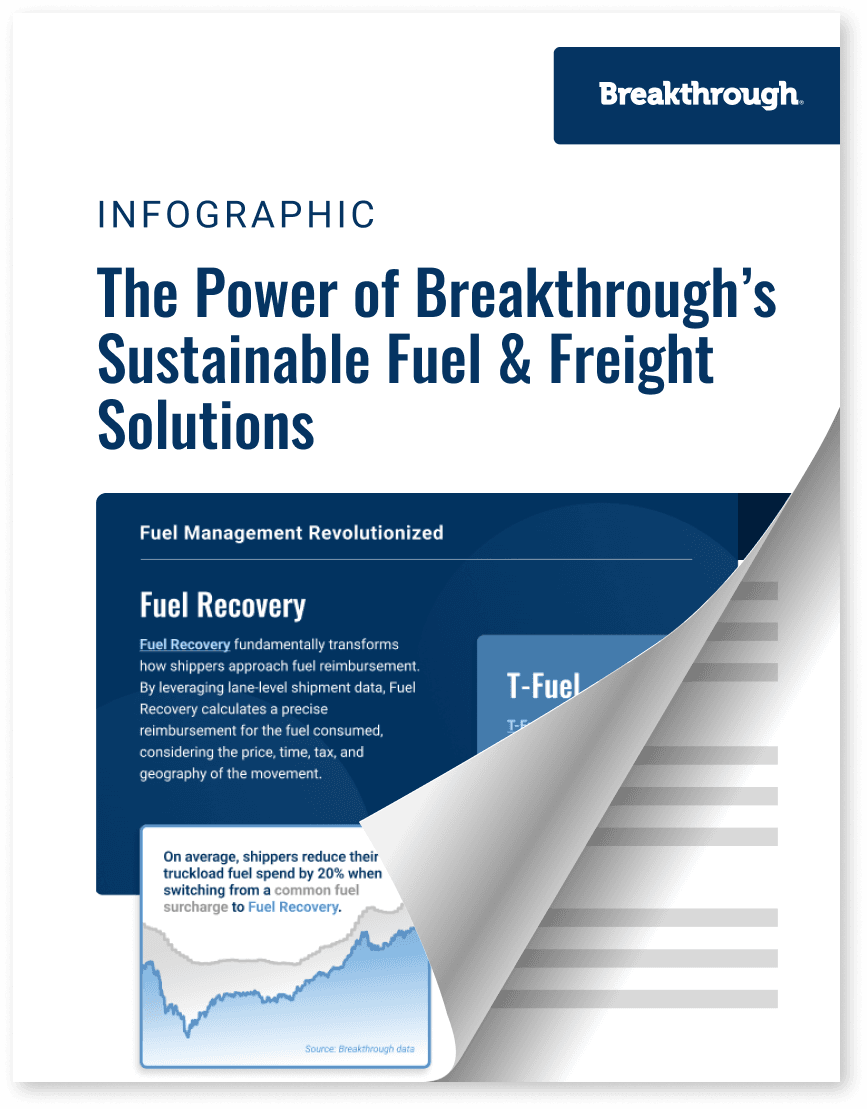The Power of Breakthrough's Sustainable Fuel and Freight Solutions

Freight
3 min read
July 17, 2024
Market Events
4 min read
July 16, 2024
Market Events
3 min read
July 8, 2024

4 min read
June 6, 2022

Share:
One of the most dynamic steps in the supply chain is the movement of goods. Shippers have product to move and carriers accept these loads through either the contract or spot market. While it is more advantageous for a shipper and a carrier to commit to freight in the contract market where they lock-in the linehaul rate, shippers sometimes need to work with a broker, use the spot market, or find a best-fit carrier through a freight capacity tool.
The ratio of loads being processed in the contract market compared to the spot market fluctuates depending on price pressures and disruptions in the freight market. This freight market cycle – often resulting in either the shipper or the carrier having the pricing power – can balance through sustainable shipper and carrier relationships.
Shippers commonly use a sourcing event or RFP to contract carriers at an agreed upon linehaul rate. Known as ‘bid season’ this event brings more freight into the contract market to lock-in loads as a reliable source of revenue for carriers and a stable cost for shippers. Linehaul rates for carriers and shippers coming out of an RFP are largely dependent on the state of the freight market.
Breakthrough’s ecosystem of data, supporting and processing over 21 million shipments and $22 billion in transportation spend, typically sees shippers operate in the contract market 80 percent of the time and 20 percent in the spot market. Since the COVID-19 pandemic, the balance has shifted to roughly 60 percent and 40 percent, respectively. This movement can shift dependent on the shipper strategy.

A collective surge in excess volume across industries triggers a shift towards carriers influencing linehaul rates in the freight market. In this situation, carriers can price their spot rate at a premium as illustrated in the line chart below between the start of COVID-19 to the start of the Russia-Ukraine war. Shippers who need to move their goods to make revenue have no alternative but to reward the carrier’s price tag. This position is costly for shippers over time. 
During this time, carriers may also reject contracted loads to earn more revenue in the spot market. While this may seem like a good option in the short-term, the consequences of these actions impact the partnership in the long-term. This cyclical effect of authority when the market changes negatively impacts transportation network efficiency – but it doesn’t need to be this way. By prioritizing sustainable relationships, shippers and carriers can stabilize market peaks and troughs.
Disruption can influence the freight market like the flip of a switch. In March 2022, the spot market softened, resulting in the spot market dropping below the contract market. In the spot market, a carrier and shipper negotiate on an open market rate for the service.
The softening offers shippers three choices for existing contracted volume, they can attempt to fulfill loads in the spot market by chasing lower costs, they can negotiate lower rates with their carriers, or they can continue operating as normal. Excess or additional volume can be transported by the same or another carrier by entering the spot market, consulting a broker, or using FELIX to find a best-fit carrier to forge a new relationship.
During a softening spot market, carrier compliance also increases in the contract market because carriers are more incentivized to take the contract freight, especially since it’s at a higher rate, and therefore, a higher profit margin. Carriers, however, should always strive to be compliant. Shippers are becoming better equipped with data and tools, such as Capac-ID, to hold carriers accountable and leverage tools to develop new carrier partnerships.
While some shippers may want to “float with the market”, moving more loads to the contract market and fostering optimal relationships is the efficient route. In this process, shippers and carriers become more resilient to market disruptions. Each party additionally stabilizes their balance sheet, reducing or removing freight market disruption. Sustainable relationships will be important to the ongoing success of this solution. Shippers can find a sustainable balance by procuring carriers that best fit their network.
FELIX recommends carriers who are more likely to maintain a relationship through freight market cycles.
For more information on investing in contract capacity solutions, read Making a Case For Contract Freight Technology & Solutions.

3 min read
July 17, 2024
Maximize transportation efficiency with cohesive fuel and freight strategies. Discover the power of enhanced visibility, cost-effectiveness, and sustainability.
Read more
4 min read
July 16, 2024
Discover how the recent elections in Mexico and the EU are expected to influence energy policies, fuel prices, and dynamics in the transportation sector.
Read more
3 min read
July 8, 2024
Understand the state-specific changes in diesel tax rates and explore strategic solutions for shippers to accurately calculate fuel reimbursements to carriers.
Read more